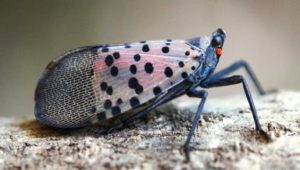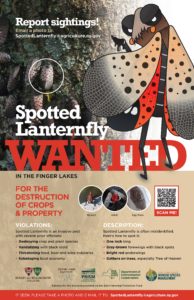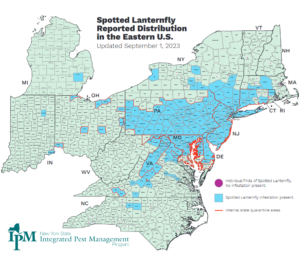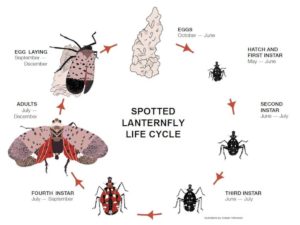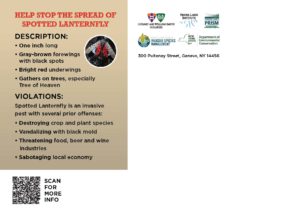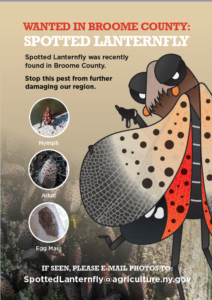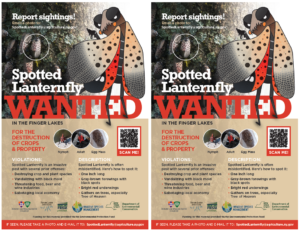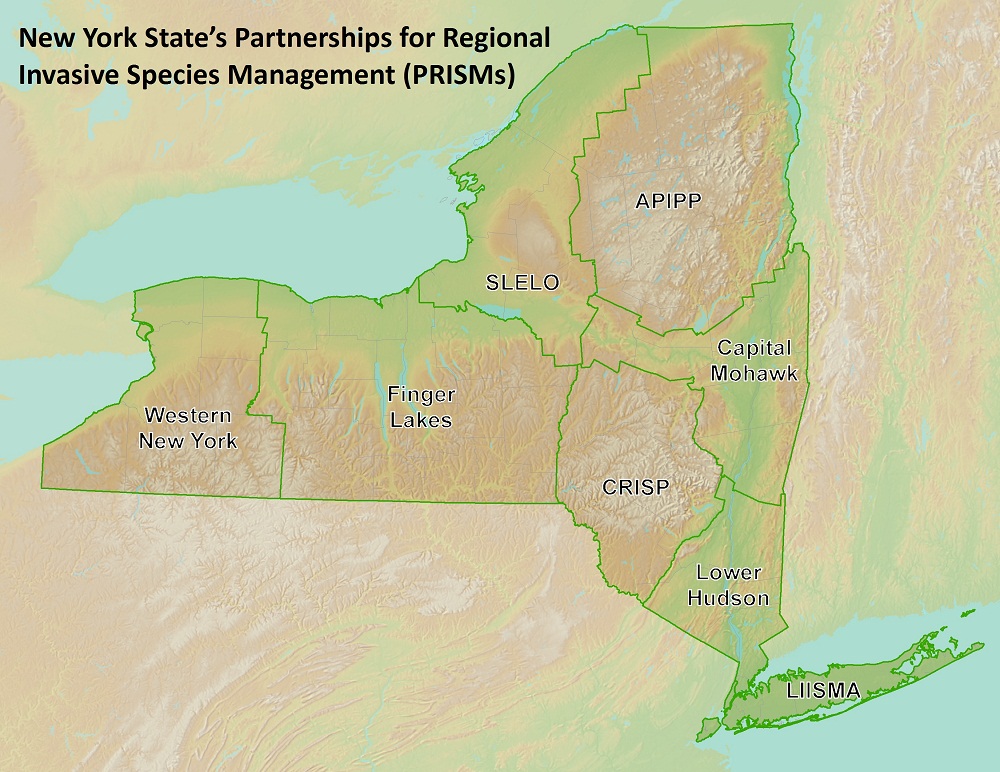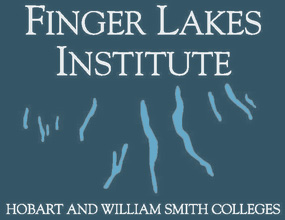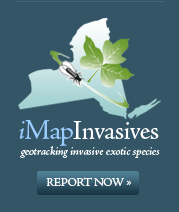WANTED IN THE FLX: Spotted Lanternfly
What is Spotted Lanternfly?
Partners who are looking for more information on SLF, please see our Emergency SLF Webinar here: https://youtu.be/PWtFUoh_vII
Note: For more information on SLF, check out our invasive species profile that has more information on its ecology. New York State Integrated Pest Management also has resources that dive further into SLF’s biology. If you believe you’ve seen SLF, please take a photo and send it to spottedlanternfly@agriculture.ny.gov
- Spotted Lanternfly (Lycorma delicatula or simply ‘SLF’) is an invasive insect originally native to China. SLF was first detected in the United States, specifically near Philadelphia in 2014, likely arriving on a cargo shipment
- Since its arrival, SLF has rapidly spread across Pennsylvania and along the east coast, eventually arriving in New York and the Finger Lakes region in 2020
- SLF is characterized by its colorful appearance with pink wings and black spots, and red coloration underneath the wings
- SLF is a large insect, frequently reaching as long as 1″
SLF has a wide host range, and commonly attacks the following plant species:
- Tree of Heaven (also an invasive species)
- Grape vines
- Fruit trees (most notably apple trees)
- Hops vines
- Maple spp.
- Walnuts
SLF feeds on our plants not by biting them, but by sucking the sap inside the plant. So if you believe you’ve seen plants damaged by SLF, make sure you know what to look for:

Sooty mold from honeydew: When SLF feed on a plant in great numbers, the stem of the plant will appear black as you can see in this picture. This is caused by honeydew – or the waste of SLF as they feed. This sticky substance attracts mold that can damage the plants even further.
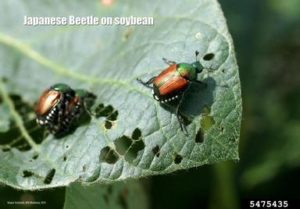
SLF does not leave holes in the plants they feed on. If you see leaves that are missing pieces or have parts clearly chewed off, it might have been from another insect, like these Japanese beetles
Range:
As of 2023, SLF has been reported in a multitude counties in New York state, including Broome, Onondaga, Tioga, and Tompkins counties here in the Finger Lakes.
Lifecycle
The SLF lifecycle has four distinct phases. An egg phase from October-June, a series of small black “instars” from June-July, a larger, red colored fourth instar from July-September, and an adult stage from July-December (depending on the local climate SLF might reach maturity earlier in the year).
Here is some important information to know about each stage of the lifecycle:
Eggs
- SLF eggs are most frequently laid on the host species they prefer, but can occur almost anywhere. Frequently in the past, eggs have been found on rocks, rusted metal, and on the bumpers and wheel bearings of vehicles. If you are stopping in an area where there is an active SLF infestation, make sure to check your vehicle!
- SLF eggs are a muted grey-purple color, and can be quite difficult to find in person. Make sure if you are looking for SLF eggs, to keep a sharp eye out
Black instars
- While as adults SLF is quite large, the initial instar phases are rather small. In fact, when SLF first hatches from its eggs, they are about the size of an ant
Red instar
- These instars are much larger than their black counterparts, and are close to the size of an adult
- These instars are capable of delivering considerable damage to plants compared to earlier phases
Adult
- Adults are the only stage in the SLF lifecycle that is capable of flight, as this is the only stage when they have wings. Earlier instars will simply hop around to move.
- Breeding activity amongst adults is highest in the early fall months of September and October, so this is most likely when you will see them
What can I do?
At the moment, SLF is only just beginning to enter New York. If you are concerned about SLF, keep an eye out for it! With your help, we may be able to identify populations and eradicate them before they have a chance to spread. If you believe you have found SLF, please take a picture of the insect and send that photo to spottedlanternfly@agriculture.ny.gov.
Making sure that you are not inadvertently spreading SLF is crucial as well. Ensure that when you are passing through areas that have an active SLF infestation, to check your vehicle and scrape off any egg masses before you leave.
Common Misconceptions
- Despite the fact that they are planthoppers, SLF is capable of long, sustained flight
- SLF DOES NOT bite humans, and they’re actually incapable of biting at all as they have no teeth
- Unlike carpenter ants or termite, SLF does not damage structures at all, they may land on houses and other buildings but do not cause any damage
SLF Outreach Program
We can only stop Spotted Lanternfly is people are aware of the threat that they pose, and they know what to do when they see it. That’s why we have a dedicated Spotted Lanternfly outreach campaign, working with partners across the region to ensure that they have the educational resources necessary to spread the word about the threat of Spotted Lanternfly. The map below details partners who have received Spotted Lanternfly outreach material from us so far. If you are interested in receiving outreach material for your own use, please email us at gallo@hws.edu. You can view the materials at the bottom of this page to see what we have available.
SLF Trapping Program
One of our most powerful tools in early detection program is trapping. Using traps can help us detect Spotted Lanternfly populations when they are still small enough to be eradicated. The map below details the efforts of our partners to establish monitoring traps in the Finger Lakes region. If you are interested in receiving traps for your own use, please email us at gallo@hws.edu.
SLF Education Resources
We provide the following materials freely for the purposes of SLF education and outreach. Take a look at what we have to offer below.
If you would like to order these materials, please email gallo@hws.edu and we will get them to you as soon as we can!
SLF Postcards (PDF:Lanternfly_Postcard_6x4.25)
SLF Trap Signs (PDF:12×18-SLF trail sign_NYSPv2)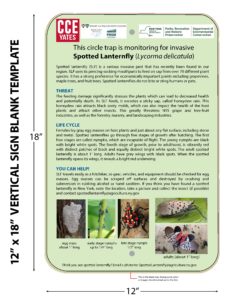
SLF Doorhangers: (PDF: SLF HYD Door Hanger 7.19.21)
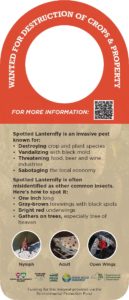
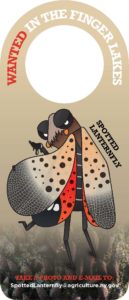
SLF Wine Tags: (PDF: SLF Wine Tag New)
Most Wanted Poster (11×17) (PDF: SLF WANTED Poster 11×17 7.19.21 (1))
Most Wanted Poster (8.5×11) (PDF: SLF WANTED Poster 8.5×11 10.12.21)
For any questions, please email us at gallo@hws.edu.
